Zwy
Solar Wizard
While he is asking, could he get a drawing with dimensions?He got right back with me on shipping. I was in no hurry so I sat back so you could lead the way. Write him again as he responded...
While he is asking, could he get a drawing with dimensions?He got right back with me on shipping. I was in no hurry so I sat back so you could lead the way. Write him again as he responded...
While he is asking, could he get a drawing with dimensions?

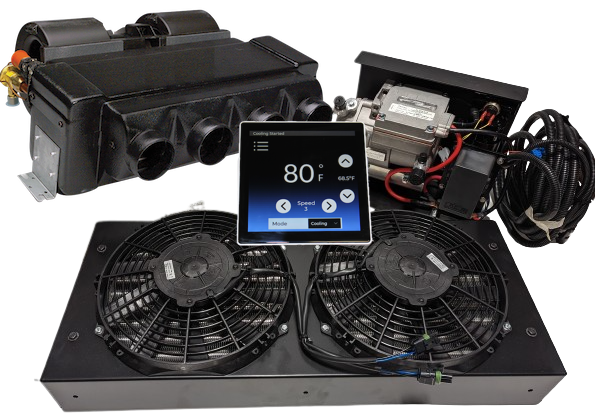
notation:
12V Undermount Air Conditioner for class B van or RV -Ducted Evaporator
In Stock. At your door in 5-7 days. *ALL Systems now come with Hush Fans* Complete UndermountAC.com 12V Split Air Conditioner Kit. Completely Battery Powered. New Condenser includes 90 degree brackets for horizontal or vertical mount and free built in rock guard! *This kit features our ducted...trumaheaters.com
Compressor Speed 3, Evaporator Speed 7: 20,000BTU/h 1300W
20,000BTU/(3.412BTU/Wt) = 5861 Wt pumped with 1300 W input : COP = 4.51 very goodCompressor Speed 2, Evaporator Speed 7: 16,000BTU/h 1100W
16,000BTU/(3.412BTU/Wt) = 4689 Wt pumped with 1100 W input : COP = 4.26 very goodCompressor Speed 1, Evaporator Speed 7: 12,000BTU/h 900W
12,000BTU/(3.412BTU/Wt) = 3517 Wt pumped with 900 W input : COP = 3.91 pretty good50 years ago a CoP of 4 was magic. Now mini-split achieving those regularly.5-10 watts of thermal energy pumped for each 1 watt of input power would be like magic, as far as i know it's not possible to reach CoP=10. but it's possible to reach CoP 5.
Right?? CoP of 4 feels like an incredible feat to have normalized.50 years ago a CoP of 4 was magic. Now mini-split achieving those regularly.
Systems that use additional heat from the sun to increase dissipation and extract work? Never in person, only read about the concept of heat flow being proportional to delta T and solar thermal collector allows increasing of delta T and therefore increase heat flow..? Maybe I am still misunderstanding some aspects.. It’s a concept I want to learn more about, because it’s so interesting efficiency wise.Have you seen Solar Thermal Hybrid A/C units?

found this helpful document about hybrid AC btw. warning: pdf link https://pdf.indiamart.com/impdf/8960243397/MY-1848302/hybrid-solar-air-conditioner.pdfThe Solar Air Conditioning unit works on a hybrid principle. It absorbs solar energy to heat the inside medium by utilizing a vacuum solar collector. The refrigerant from the compressor goes through a copper coil inside the collector and undertakes a heat exchange. The heated refrigerant then goes through a cycle inside the system for not only for heating but also for cooling too. Energy from the sun is fully utilized so therefore less power is required from the mains in this process, this, in turn, allows for smaller compressors to be installed that offer even better savings on power consumption. This system adopts a four-fold type heat exchanger as one of the core components of this air-conditioner. Its heat effective area is increased by 20-30% versus the usual V-type and flat plate heat exchanger, which greatly increases cooling efficiency.
excerpt:It is like your car going down a gentle slope. You can take your foot off of the accelerator for a longer period as gravity helps your car keep moving. Therefore it is using less energy for a longer period and will lower your power bills even further. But how do Solar Thermal Air conditioners do this? They absorb solar energy by using a thermal collector with copper heat conducting inner coils. The preheated refrigerant from the collector feeds directly into the compressor to reduce the amount of work needed and saves power.

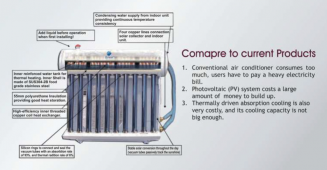

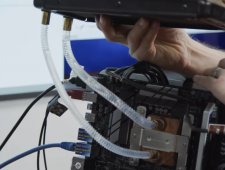
With enough solar heat available you are basically building a absorption style RV refrigerator. Theoretical you could build one without any moving parts. (but fans make it more efficient)Cheers!
edit: Originally overlooked this part you mentioned about the heat causing the refrigerant flow itself, that sounds super fun! Two fans and a thermal collector and an expansion valve or something..? With a compressor for kickstart or auxiliary use at night.? Cool! Copper heat pipes with low pressure atmosphere and a bit of water and a wick seem to do something similar. Really interesting concept module to try and integrate.

With enough solar heat available you are basically building a absorption style RV refrigerator. Theoretical you could build one without any moving parts. (but fans make it more efficient)
I think those whole concept is very interesting since there are now Solar PV Thermal panels are coming out.

DualSun SPRING
DualSun designs and manufactures the world’s first certified hybrid solar panel (PVT): the SPRING 2-in-1 panel.dualsun.com
So practically you get electricity and heat from the same space - which would be a lot of energy per sqft - which is very important for a RV/ Vehicle. Since we don't have a lot of space.
The issue I saw with powering a absorption fridge was not total energy, but temperature. The propane burns with above 1000 degree and a electric heating element reaches 300 degrees C easy.Doesn't take much, my other pop up camper refrigerator uses a 12V/135w heating element for the 3 way. I think capacity is the limiting factor, look how long it takes to cool down a 3 way fridge using propane or 120V.
The unit is not manufactured by Truma, but by Proair. It was designed exclusively for Roadtrek before they went bankrupt. This reseller purchased all of the remaining stock when Roadtrek was liquidated. It features a 12 v Benling compressor that is used by multiple 12 v ac manufacturers. The kit comes complete and I’m in the process of installing it now in my Promaster based Hymer Aktiv Loft. I just finished ripping out the proprietary Ecotrek system and installing my own 1180 amp hour diy power system (detailed elsewhere on this forum) with the final goal of running ac overnight without hookups. I’ll create a post with the results once I’m finished. I’m waiting on some additional hoses due to come in tomorrow and should have the project completed by then.Something new just popped up. 12V 20.000 BTU from Truma only 1300w
That's almost 16 BTU / watt. For comparison any regular roof top RV unit gets a maximum of 10 BTU / Watt. So that's 60% better.
Truma is a very good company.
But the website is rather suspicious:

12V Undermount Air Conditioner for class B van or RV -Ducted Evaporator
In Stock. At your door in 5-7 days. *ALL Systems now come with Hush Fans* Complete UndermountAC.com 12V Split Air Conditioner Kit. Completely Battery Powered. New Condenser includes 90 degree brackets for horizontal or vertical mount and free built in rock guard! *This kit features our ducted...trumaheaters.com
Here's the COP data for the 12V Bengling.The unit is not manufactured by Truma, but by Proair. It was designed exclusively for Roadtrek before they went bankrupt. This reseller purchased all of the remaining stock when Roadtrek was liquidated. It features a 12 v Benling compressor that is used by multiple 12 v ac manufacturers. The kit comes complete and I’m in the process of installing it now in my Promaster based Hymer Aktiv Loft. I just finished ripping out the proprietary Ecotrek system and installing my own 1180 amp hour diy power system (detailed elsewhere on this forum) with the final goal of running ac overnight without hookups. I’ll create a post with the results once I’m finished. I’m waiting on some additional hoses due to come in tomorrow and should have the project completed by then.
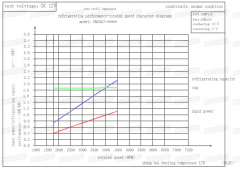
Wow that’s a really neat product. Great point about RVs and space optimization. Extracting heat from the PV cells should extend lifetime too and maybe even boost voltage slightly…I think those whole concept is very interesting since there are now Solar PV Thermal panels are coming out.

DualSun SPRING
DualSun designs and manufactures the world’s first certified hybrid solar panel (PVT): the SPRING 2-in-1 panel.dualsun.com
So practically you get electricity and heat from the same space - which would be a lot of energy per sqft - which is very important for a RV/ Vehicle. Since we don't have a lot of space.

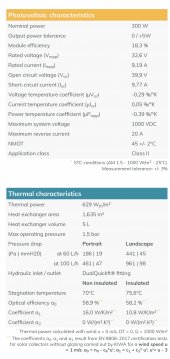
Here's the COP data for the 12V Bengling.
View attachment 55853
COP of 1.9, for 6800 BTU capacity (2000 watts), we can see it uses about 1100 watts at 4500 rpm.
At the lower end of rpm, COP is still the same, and we have 2700 BTU's (800 watts).
Where is the advantage over a mini split with a COP of 3 or 4, even with inverter losses?
This is also only rated for 5500 BTU's (1600 watts). At it's rated full capacity, it will use 900 watts of power. This doesn't include fans needed for air exchange.
Most of the total energy usage in an RV is actually thermal.Wow that’s a really neat product. Great point about RVs and space optimization. Extracting heat from the PV cells should extend lifetime too and maybe even boost voltage slightly…
Thanks for sharing.Anyone considering the new midea/toshiba dual hose inverter portable heatpump? Not dc, but even with inverter losses seems like it's by far the cheapest, quietest, most efficient, and most roof friendly(and stealthy) option. It's as efficient as most window acs and vastly cheaper, smaller, lighter and easier ton install
than mini splits.
Edit:. Here's the link(also on Amazon for similar price) https://www.homedepot.com/p/Toshiba...eat-for-up-to-550-sf-RAC-PT1411HWRU/314730948
The datasheet is right off Benling site.The Roadtrek Truma System has apparently 20.000 BTU @ 1300w
You must have a different data sheet.
20,000BTU/(3.412BTU/Wt) = 5861 Wt pumped with 1300 W input : COP = 4.51 very good


